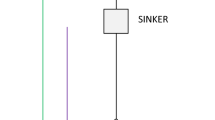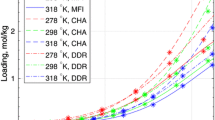Abstract
Molecular modelling, utilising the Grand Canonical Monte Carlo method, was employed to study the interactions between nitrous oxide (N2O) and nitric oxide (NO) with a solid matrix, namely mordenite, before and after charge equilibration. The results indicate that the charge equilibration leads to an adsorption which is independent of the pressure. Comparison with gas-chromatographic experiments indicate that charge equilibration is not allowed in acid mordenite. Therefore, in the case of polar molecules, their adsorption depends on the charge in the zeolite micropores.
Furthermore, molecular modelling can be utilised to also predict gas-solid-chromatographic separations, provided that calculations take into account the presence of the carrier gas to obtain an approach of calculated separation factors similar to those found experimentally.
Similar content being viewed by others
References
M.A. Galan, Chem. Eng. J. 28, 105 (1984).
E. Guglielminotti, F. Boccuzzi, M. Manzoli, F. Pinna, and M. Scarpa, J. Catal. 192, 149 (2000).
F. Pinna, M. Scarpa, G. Strukul, E. Guglielminotti, F. Boccuzzi, and M. Manzoli, J. Catal. 192, 158 (2000).
I.V. Mitchell (Ed.), in Pillared Layered Structures. Current Trends and Applications (Elsevier Applied Science, Amsterdam, 1990).
G. Ertl, H. Knozinger, and J. Weitkamp (Eds.), in Handbook of Heterogeneous Catalysis (Wiley, New York, 1998) vol. 4, ch. 1, for overview of current de-NOx technology for both standing and moving sources.
A.A.G. Tomlinson, J. Porous Materials 5, 259 (1998).
K. Shimizu, F. Okada, Y. Nakamura, A. Satsuma, and T. Hattori, J. Catal. 195, 151 (2000).
J. Leglise, J.O. Petunchi, and W.K. Hall, J. Catal. 86, 392 (1984).
K. de Boer, A.P.J. Jamsen, and R.A. van Santen, Chem. Phys. Letters 223, 46 (1994).
A.J. Richards, K. Watanabe, N. Austin, and M.R. Stapleton, J. Porous Materials 2, 43 (1995).
R. Aubeau, L. Champeix, and J. Reiss, J. Chromatog. 6, 209 (1961).
J.E. Purcell, Nature 201, 1321 (1964).
J. King and S.W. Benson, Anal. Chem. 38, 261 (1966).
S.A. Greene, Anal. Chem. 31, 480 (1959).
O.L. Hollis, Anal. Chem. 38, 309 (1966).
D.H. Smith and E. Clark, Proc. Soil Science Soc. Am. 11, 111 (1960).
J.N. Murray and J.B. Doe, Anal. Chem. 37, 941 (1965).
N. Metropolis, A.W. Rosenbluth, M.N. Rosenbluth, A.H. Teller, and E. Teller, J. Chem Phys. 21, 1087 (1953).
A.K. Rappé and W.A. Goddard III, J. Phys. Chem. 95, 3358 (1991).
A.K. Rappé, C.J. Casewit, K.S. Colwell, W.A. Goddard III, and W.M. Skiff, J. Am. Chem. Soc. 114, 10024 (1992).
P.P. Ewald, Ann. der Physik 64, 253 (1921).
E.G. Derouane, G. Crehan, C.J. Dillon, D. Bethell, H. He, and S.B. Derouane-Abd Hamid, J. Catal. 194, 410 (2000).
R.A. van Santen and G.J. Kramer, Chem. Rev. 95, 637 (1995).
Author information
Authors and Affiliations
Rights and permissions
About this article
Cite this article
De Stefanis, A., Romani, G., Semprini, E. et al. Molecular Modelling of N2O/NO Separation in Acid Mordenite: Comparison with Gas-Chromatographic Experiments. Journal of Porous Materials 9, 97–104 (2002). https://doi.org/10.1023/A:1020878324464
Issue Date:
DOI: https://doi.org/10.1023/A:1020878324464




